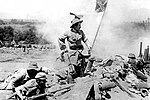The 1971 San Fernando earthquake (also known as the 1971 Sylmar earthquake) occurred in the early morning of February 9 in the foothills of the San Gabriel Mountains in southern California. The unanticipated thrust earthquake had a magnitude of 6.5 on the Ms scale and 6.6 on the Mw scale, and a maximum Mercalli intensity of XI (Extreme). The event was one in a series that affected Los Angeles county in the late 20th century. Damage was locally severe in the northern San Fernando Valley and surface faulting was extensive to the south of the epicenter in the mountains, as well as urban settings along city streets and neighborhoods. Uplift and other effects affected private homes and businesses.
The event affected a number of health-care facilities in Sylmar, San Fernando, and other densely populated areas north of central Los Angeles. The Olive View Medical Center and Veterans Hospital both experienced very heavy damage, and buildings collapsed at both sites, causing the majority of deaths that occurred. The buildings at both facilities were constructed with mixed styles, but engineers were unable to thoroughly study the buildings' responses because they were not outfitted with instruments for recording strong ground motion; this prompted the Veterans Administration to later install seismometers at its high-risk sites. Other sites throughout the Los Angeles area had been instrumented as a result of local ordinances, and an unprecedented amount of strong motion data was recorded, more so than any other event up until that time. The success in this area spurred the initiation of California's Strong Motion Instrumentation Program.
Transportation around the Los Angeles area was severely afflicted with roadway failures and the partial collapse of several major freeway interchanges. The near total failure of the Lower Van Norman Dam resulted in the evacuation of tens of thousands of downstream residents, though an earlier decision to maintain the water at a lower level may have contributed to saving the dam from being overtopped. Schools were affected, as they had been during the 1933 Long Beach earthquake, but this time amended construction styles improved the outcome for the thousands of school buildings in the Los Angeles area. Another result of the event involved the hundreds of various types of landslides that were documented in the San Gabriel Mountains. As had happened following other earthquakes in California, legislation related to building codes was once again revised, with laws that specifically addressed the construction of homes or businesses near known active fault zones.





